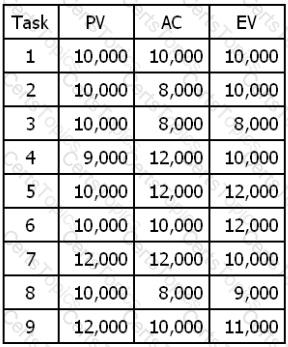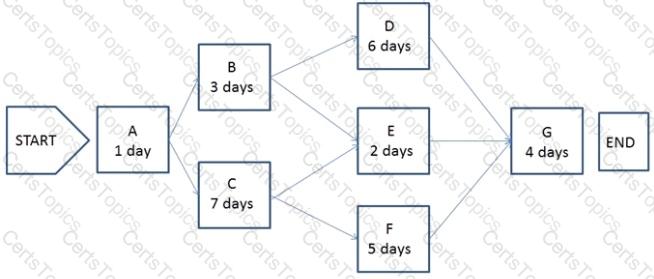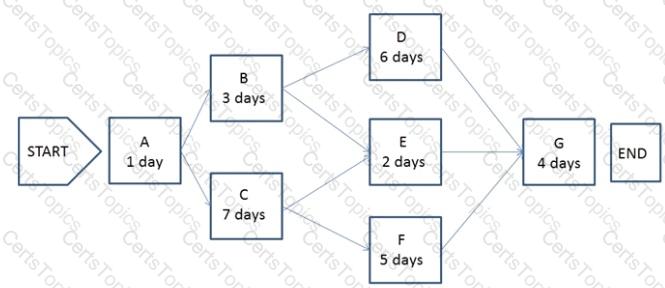Which of the following outputs from the Control Schedule process aids in the communication of schedule variance (SV), schedule performance index (SPI), or any performance status to stakeholders?
Tools and techniques used for Plan Communications include the communication:
Prioritizing risks for further analysis or action by assessing and combining their probability of occurrence and impact takes place in which process?
A project has an EV of 100 workdays, an AC of 120 workdays, and a PV of 80 workdays. What should be the concern?
Which of the following is an input to the Direct and Manage Project Execution process?
Which activity involves ensuring that the composition of a projects configuration items is correct?
Which is an input to the Verify Scope process?
A tool or technique in Perform Quality Control that a project manager would use is:
Which cost estimate technique includes contingencies to account for cost uncertainty?
What is the most accurate rough order of magnitude (ROM)?
The Project Management Process Group in which performance is observed and measured regularly from project initiation through completion is:
The output that defines an approach to increase the support and minimize negative impacts of stakeholders is the:
In which Process Group are lessons learned documented?
An input to the Perform Quantitative Risk Analysis process is the:
The purpose of inspection in Perform Quality Control is to keep errors:
Which of the following correctly explains the term "progressive elaboration'?
What does a CPI value greater than 1.0 indicate?
Which can be used to determine whether a process is stable or has predictable performance?
Which of the following terms indicates a deliverable-oriented hierarchical decomposition of the project work?
Which technique is commonly used for the Perform Quantitative Risk Analysis process?
A risk that arises as a direct result of implementing a risk response is called a:
A projects purpose or justification, measurable project objectives and related success criteria, a summary milestone schedule, and a summary budget are all components of which document?
Project managers who lead by example and follow through on the commitments they make demonstrate the key interpersonal skill of:
Project Stakeholder Management focuses on:
The following chart contains information about the tasks in a project.

Based on the chart, what is the cost variance (CV) for Task 6?
Impacts to other organizational areas, levels of service, and acceptance criteria are typical components of which document?
The following is a network diagram for a project.

What is the critical path for the project?
The following is a network diagram for a project.

How many possible paths are identified for this project?
Which is an enterprise environmental factor?
Through whom do project managers accomplish work?
Analytical techniques are a tool and technique of which process in Project Procurement Management?
The following is a network diagram for a project.

What is the critical path for the project?
Which enterprise environmental factors may influence Plan Schedule Management?
When the business objectives of an organization change, project goals need to be:
A project requires a component with well-understood specifications. Performance targets are established at the outset, and the final contract price is determined after completion of all work based on the seller's performance. The most appropriate agreement with the supplier is:
Whose approval may be required for change requests after change control board (CCB) approval?
Requirements documentation will typically contain at least:
The following is a network diagram for a project.

The shortest non-critical path for the project is how many days in duration?
While processes in the Planning Process Group seek to collect feedback and define project documents to guide project work, organizational procedures dictate when the project planning:
A project manager should communicate to stakeholders about resolved project issues by updating the:
Project management processes ensure the:
The contract in which the seller is reimbursed for all allowable costs for performing the contract work and then receives a fee based upon achieving certain performance objectives is called a:
Which quality control technique illustrates the 80/20 principle?
Who is responsible for initiating a project?
Who determines which dependencies are mandatory during the Sequence Activities process?
Requirements documentation, requirements management plan, and requirements traceability matrix are all outputs of which process?
The group technique that enhances brainstorming with a voting process used to rank the most useful ideas for prioritization is called the:
Which of the following are three inputs to the risk register?
Which of the following is an estimating technique that uses the values of parameters from previous similar projects for estimating the same parameter or measure for a current project?
Which risk response strategy is common for both positive and negative risks?
An input to the Estimate Activity Resources process is:
Prototype development may be used as a tool for which of the following risk response strategies?
In which type of contract are the performance targets established at the onset and the final contract price determined after completion of all work based on the sellers performance?
The item that provides more detailed descriptions of the components in the work breakdown structure (WB5) is called a WBS:
Activity cost estimates are quantitative assessments of the probable costs required to:
The process improvement plan details the steps for analyzing processes to identify activities which enhance their:
Which of the following change requests can bring expected future performance of the project work in line with the project management plan?
Which of the following is a statistical concept that calculates the average outcome when the future includes scenarios that may or may not happen?
The processes required to establish the scope of the project, refine the objectives, and define the course of action required to attain the objectives that the project has been undertaken to achieve are grouped within which Process Group?
Which statement correctly describes the value of a business case?
The process for performing variance analysis may vary, depending on:
The project has a current cost performance index of 0.80. Assuming this performance wi continue, the new estimate at completion is $1000. What was the original budget at completion for the project?
The planned work contained in the lowest level of work breakdown structure (WBS) components is known as:
What is the schedule performance index (SPI) if the planned value (PV) is $100, the actual cost (AC) is $150, and the earned value (EV) is $50?
Identify Risks is part of which Process Group?
Which tool or technique of the Define Activities process allows for work to exist at various levels of detail depending on where it is in the project life cycle?
An input to Close Project or Phase is:
Which process involves subdividing project deliverables and project work into smaller, more manageable portions?
An input to the Identify Stakeholders process is:
Which document describes the necessary information to determine if a project is worth the required investment?
The Identify Stakeholders process is found in which Process Group?
During which process does a project manager review all prior information to ensure that all project work is completed and that the project has met its objectives?
The iterative and interactive nature of the Process Groups creates the need for the processes in which Knowledge Area?
Which process identifies whether the needs of a project can best be met by acquiring products, services, or results outside of the organization?
An output of the Plan Quality Management process is:
Which Define Activities output extends the description of the activity by identifying the multiple components associated with each activity?
Which risk management strategy seeks to eliminate the uncertainty associated with a particular upside risk by ensuring that the opportunity is realized?
Which group is formally chartered and responsible for reviewing, evaluating, approving, delaying, or rejecting changes to the project and for recording and communicating decisions?
A logical relationship in which a successor activity cannot start until a predecessor activity has finished is known as:
Which input to the Plan Risk Management process provides information on high-level risks?
Which Process Group and Knowledge Area include the Sequence Activities process?
External organizations that have a special relationship with the enterprise and provide specialized expertise are called:
The Perform Integrated Change Control process occurs in which Process Group?
Which is the Define Scope technique used to generate different approaches to execute and perform the work of the project?
A project manager seeking insight on previous stakeholder management plans and their effectiveness should evaluate:
What is the name of the statistical method that helps identify which factors may influence specific variables of a product or process under development or in production?
Which illustrates the connection between work that needs to be done and its project team members?
Who, along with the project manager, is supposed to direct the performance of the planned project activities and manage the various technical and organizational interfaces that exist within the project?
What type of reward can hurt team cohesiveness?
Which enterprise environmental factors are considered during Estimate Costs?
Which process involves aggregating the estimated costs of the individual schedule activities or work packages?
The project manager notes that stakeholders are aware of the project and potential impacts and are actively engaged in ensuring that the project is a success. The engagement level of the stakeholders should be classified as:
An electronics firm authorizes a new project to develop a faster, cheaper, and smaller laptop after improvements in the industry and electronics technology. With which of the following strategic considerations is this project mainly concerned?
When an activity cannot be estimated with a reasonable degree of confidence, the work within the activity is decomposed into more detail using which type of estimating?
Definitions of probability and impact, revised stakeholder tolerances, and tracking are components of which subsidiary plan?
Which of the following is a tool and technique for Estimate Activity Durations?
Project or phase closure guidelines or requirements, historical information, and the lessons learned knowledge base are examples of which input to the Close Project or Phase process?
Which type of contract is most commonly used by buying organizations because the price for goods is set at the outset and is not subject to change unless the scope of work changes?
What is the name of a graphic display of project team members and their reporting relationships?
The formal and informal interaction with others in an organization industry, or professional environment is known as:
A work package has been scheduled to cost $1,000 to complete and was to be finished today. As of today, the actual expenditure is $1,200 and approximately half of the work has been completed. What is the cost variance?
Organizations perceive risks as:
The project management processes presented in the PMBOK Guide® should:
When can pre-assignment of project team members occur?